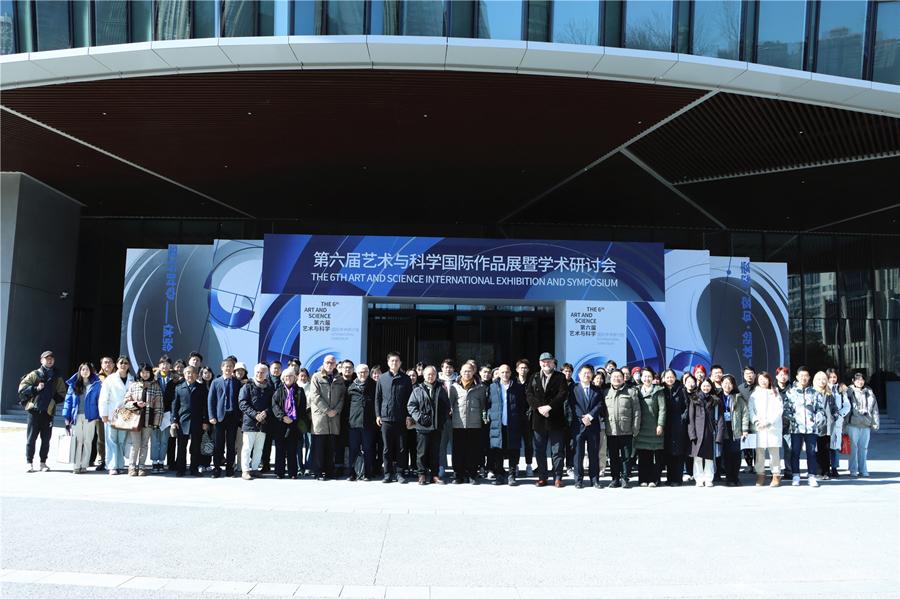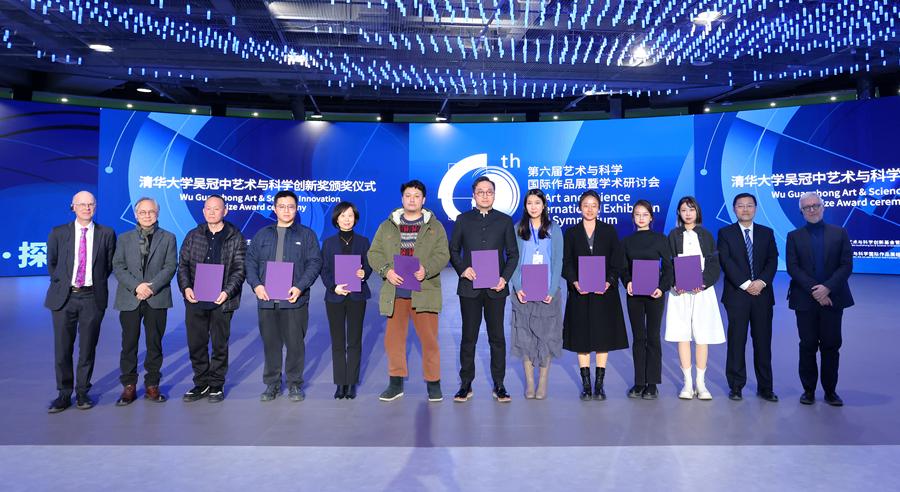An international symposium was held in early March in Beijing, where global scholars and experts discussed the opportunities presented by continuous technological advances in various fields from the perspectives of science and art, as well as their visions for future development. They also selected the best science-inspired artworks displayed in an intriguing exhibition.

Experts, scholars, and guests pose for a group photo outside the National Communication Center for Science and Technology, the venue for the 6th Art and Science International Symposium in Beijing, March 2, 2024. [Photo courtesy of AADTHU]
The Academy of Arts & Design of Tsinghua University (AADTHU) and the Tsinghua University Art and Science Research Center co-organized the 6th Art and Science International Symposium in Beijing from March 1-2. More than 30 distinguished artists and scientists from both China and around the world delivered keynote speeches, exploring the mutual inspiration and integration between art and science amidst ongoing technological advancements.
Qin Chuan, AADTHU Party secretary, told China.org.cn that the academy has paid close attention to the rapid development of science and technology in recent years, particularly in artificial intelligence (AI). "Revolutions and innovations in science and technology consistently have a huge impact, even a decisive and subversive effect, on artistic creation," he said. "This year's symposium is themed 'Parallel Time and Space,' which I interpret as the evolution of technology providing great possibilities for everyone. Essentially, this theme is about envisioning the future based on the foundation of today's technological development."
"But the development of science and technology is often a double-edged sword," he added. "It has a positive driving effect but can also bring about some negative impacts that we may not anticipate. One of the goals of our event is to better integrate the pursuit of truth in science, the pursuit of goodness in ethics, and the pursuit of beauty in art in an era full of changes. This integration aims to better explore a correct and sustainable path for the future development of human society."
On March 2, the symposium culminated in the awards ceremony for the Wu Guanzhong Art and Science Innovation Prize. Eight works, selected from 93 exhibits from 13 countries and regions, received the prize. The awards were based on their originality, artistry, scientific merit, theme, and social impact, as determined through an anonymous voting process by the 11-member international evaluation committee. According to Lu Xiaobo, a distinguished professor of arts, humanities, and social sciences at Tsinghua University, the prize fund originated from 12.76 million Hong Kong dollars ($1.6 million) obtained from auctioning Wu Guanzhong's renowned painting, "The Ten-Thousand-Li Landscape of the Yangtze River."
Lu believes we are in an era of diversity that values creativity more than ever. The symposium and exhibition underscored this by embracing a variety of thoughts and ideas, encouraging inspiration and motivation among participants.

Winners of the Wu Guanzhong Art and Science Innovation Prize receive awards during the 6th Art and Science International Symposium, held at the National Communication Center for Science and Technology in Beijing, March 2, 2024. [Photo courtesy of AADTHU]
"Facing the future, we must adopt an open and inclusive attitude for free academic exploration. This will allow us to gain more diverse and different perspectives to examine our world and its future development. This holds significant and profound importance, especially in the spirit of building a harmonious global community of shared future, far beyond any single discipline or industry. It's about considering these issues from a higher standpoint," he said.
The fusion of arts and technologies holds great promise and practical value for the future. Cheng Jing, chair professor of the Department of Biomedical Engineering at Tsinghua University's School of Medicine and an academician of the Chinese Academy of Engineering, shared a case in an interview with China.org.cn. He described how he used music and color to improve the emotional well - being and condition of a patient with terminal cancer. He suggested that in the future, art and design - including both artistic and practical designs for medical equipment - could be deeply integrated into and serve the medical healing process. Meanwhile, technologies like AI could help improve and monitor people's health, leveraging the arts' impact on humans beyond the study of drugs.
AI was a frequently and typically mentioned topic at the symposium. Fang Ming, vice president of iFLYTEK, noted that the broad capabilities of large-scale cognitive models are inspiring people's imaginations like never before. "I often say that in the future workplace, the most important professional skill will not be your mastery of knowledge, but rather your imagination," he stated.
He stated that the development of cognitive macro-models will significantly disrupt industries and create new opportunities, transform how information is distributed and acquired, innovate content production methods, and comprehensively enhance human-computer interaction. According to Fang, these AI models can offer inclusive access to high-quality resources for public welfare, accelerate scientific research outputs, and drive fundamental changes in the industrial ecosystem.
Wang Yueting, vice president of Midjourney China, firmly believes that the era of AI + Art is on the verge of arrival and will significantly change every aspect of human life, especially in the art industry. Currently, OpenAI and Midjourney are making it easier and more cost-effective for the public to access art created by artificial intelligence.
"Our era is one in which AI holds the pen and brush, marking the advent of co-creation between AI and humans in the realm of art. Without the need for a physical tool, we can paint and make films. We just need to think, expand our imagination, ponder our concepts, decide on the themes we want to create, choose our paths to realization, and deepen our understanding of basic artistic knowledge. This will completely disrupt traditional methods of creation, granting us much greater freedom," she said.

A speaker delivers her speech during the 6th Art and Science International Symposium held at the National Communication Center for Science and Technology in Beijing, March 1, 2024. The event is co-hosted by the center, Tsinghua University, and the China Science and Technology Museum. [Photo courtesy of AADTHU]
"Now, everybody can use artificial intelligence," mused Peter Childs, founding director of the Dyson School of Design Engineering at Imperial College London. "It adds to our capability. I would suggest, as many observers have said, that artificial intelligence is not the whole answer, but by using it, perhaps we can make the world a better place."
Srini Srinivasan, chief operating officer of the Design Innovation Institute Shanghai, described the symposium and exhibition as "very brilliant" and stated that it truly showcased new technologies and scientific scenarios. "China has a very rich culture, but China is also very explorative in the sense that its artists explore quite a lot in terms of different fields and different ideas," he said, convinced that technologies enhance human efficiency and versatility. "Today, we are living in a complex world. Previously, you were just a carpenter, a painter, or an engineer, but today there are no boundaries. You could be a carpenter, a painter, and an engineer. Our human brains are now trained to do multiple things. That's how life is going to be for us in the next few years."